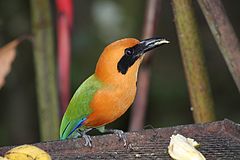Baryphthengus
| Baryphthengus[1] | |||
| Cabanis & Heine, Sr., 1859[2] | |||
 Przedstawiciel rodzaju – piłodziób rdzawy (B. martii) | |||
| Systematyka | |||
| Domena | |||
|---|---|---|---|
| Królestwo | |||
| Typ | |||
| Podtyp | |||
| Gromada | |||
| Podgromada | |||
| Infragromada | |||
| Rząd | |||
| Nadrodzina | |||
| Rodzina | |||
| Rodzaj | Baryphthengus | ||
| Typ nomenklatoryczny | |||
Baryphonus ruficapillus Vieillot, 1818 | |||
| Synonimy | |||
| |||
| Gatunki | |||
| |||
Baryphthengus – rodzaj ptaka z rodziny piłodziobów (Momotidae).
Zasięg występowania
Rodzaj obejmuje gatunki występujące w Ameryce Centralnej i Południowej[4].
Morfologia
Długość ciała 42–47 cm; masa ciała 140–208 g[4].
Systematyka
Etymologia
- Baryphthengus: gr. βαρυφθογγος baruphthongos i βαρυφθεγκτης baruphthenktēs „głośno ryczący, nisko brzmiący”, od βαρυς barus „ciężki”; φθεγγομαι phthengomai „mówić”[5].
- Urospatha: gr. ουρα oura „ogon”; σπαθη spathē „szpachelka”[6]. Gatunek typowy: Prionites martii von Spix, 1824.
Podział systematyczny
Do rodzaju należą następujące gatunki[7]:
- Baryphthengus martii (von Spix, 1824) – piłodziób rdzawy
- Baryphthengus ruficapillus (Vieillot, 1818) – piłodziób rdzawogłowy
Przypisy
- ↑ Baryphthengus, [w:] Integrated Taxonomic Information System [online] (ang.).
- ↑ J. Cabanis & F. Heine: Museum Heineanum: Verzeichniss der ornithologischen Sammlung des Oberamtmann Ferdinand Heine, auf Gut St. Burchard vor Halberstadt. Cz. 2: Schreivögel. Halberstadt: In Commission bei R. Frantz, 1859–1860, s. 114. (niem.).
- ↑ T. Salvadori. Nota intorno ad Alcuni uccelli di Costa Rica. „Atti della Academia della Scienze di Torino”. 4, s. 180, 1868. (fr.).
- ↑ a b D.W. Winkler, S.M. Billerman & I.J. Lovette: Motmots (Momotidae), version 1.0. W: S.M. Billerman, B.K. Keeney, P.G. Rodewald & T.S. Schulenberg (red.): Birds of the World. Ithaca, NY: Cornell Lab of Ornithology, 2020. DOI: 10.2173/bow.momoti1.01. [dostęp 2020-10-13]. (ang.).

- ↑ Baryphthengus, [w:] The Key to Scientific Names, J.A. Jobling (red.), [w:] Birds of the World, S.M. Billerman et al. (red.), Cornell Lab of Ornithology, Ithaca [dostęp 2022-01-23] (ang.).
- ↑ Urospatha, [w:] The Key to Scientific Names, J.A. Jobling (red.), [w:] Birds of the World, S.M. Billerman et al. (red.), Cornell Lab of Ornithology, Ithaca [dostęp 2022-01-23] (ang.).
- ↑ Systematyka i nazwy polskie za: P. Mielczarek & M. Kuziemko: Rodzina: Momotidae Gray,GR, 1840 (1832-33) - piłodzioby - Motmots (wersja: 2019-10-10). [w:] Kompletna lista ptaków świata [on-line]. Instytut Nauk o Środowisku Uniwersytetu Jagiellońskiego. [dostęp 2021-07-17].
Media użyte na tej stronie
Autor: Jakob Voß, influenced by original art designed at PLoS, modified by Wikipedia users Nina and Beao, Licencja: CC0
Closed Access logo, derived from PLoS Open Access logo. Alternative version.
Autor: (of code) -xfi-, Licencja: CC BY-SA 3.0
The Wikispecies logo created by Zephram Stark based on a concept design by Jeremykemp.
Autor: Dominic Sherony, Licencja: CC BY-SA 2.0
A Rufous Motmot in Panama.


